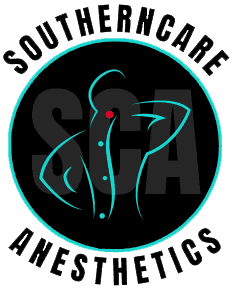Stellate Ganglion Block for Anxiety and Depression in Hattiesburg, MS
A Stellate Ganglion Block (SGB) is an emerging treatment option showing promise in managing symptoms of anxiety and depression. By targeting the stellate ganglion nerves, this procedure aims to provide relief for individuals who haven’t found success with traditional therapies. Stellate Ganglion Blocks for Anxiety and Depression are available at Southern Care Anesthetics. For more information, contact us or book an appointment. We are located at 4 Willow Point Ste 1B Hattiesburg, MS 39402.




Table of Contents:
Does a stellate ganglion block help with anxiety?
Does an SGB help with depression?
Who should not get a stellate ganglion block?
How long does it take for stellate ganglion block to work on anxiety and depression?
The stellate ganglion (SG) is part of the cervical sympathetic chain, formed by the fusion of the inferior cervical ganglion with the first thoracic sympathetic ganglion. It provides sympathetic input to the ipsilateral upper extremity, chest, face, and head. A successful block of the SG is when the patient experiences Horner’s syndrome, an increase in skin temperature, and blood flow on the same side as the injection. The stellate ganglion block (SGB) has been used to treat sympathetically mediated pain for over a century and its use can be dated back to World War I.
If pain is thought to be sympathetically mediated, the benefits of the SGB usually outlast the local anesthetics agents used in the injection. In theory, blocking sympathetic neurons causes a brief interruption of the positive feedback loop that alters input from the PNS to the CNS. This brief interruption reduces the central excitability associated with sympathetically mediated pain states. Think of the SGB as a “reset” button on a computer, it allows the body to reboot itself through autoregulation and potentially eliminate symptoms by restoring balance to the ANS.
At Southern Care Anesthetics, we pride ourselves on staying at the forefront of the latest medical explorations and breakthroughs. In line with this, we have been closely monitoring the emergence of the Stellate Ganglion Block (SGB) as a potential secondary treatment for anxiety.
SGB, a minimally invasive medical procedure traditionally employed to alleviate pain, involves injecting a local anesthetic near the stellate ganglion, a nerve cluster found in the neck. This procedure impacts the sympathetic nervous system, which governs the body’s ‘fight or flight’ response. By blocking sympathetic nerve transmission, SGB can potentially reduce physical symptoms of anxiety, such as excessive worry, nervousness, rapid heart rate, sweating, and muscle tension.
Recent clinical studies, including one published in the American Journal of Psychiatry, have indicated that patients with varying anxiety disorders like generalized anxiety disorder, post-traumatic stress disorder, panic disorder, and social anxiety disorder have experienced significant improvements in their symptoms compared to those who received a placebo.
Our team of experienced interventional radiologists and pain specialists are well-equipped to perform this procedure, which typically takes 15-30 minutes. With local anesthesia applied around the injection site and needle insertion guided by fluoroscopy, patient comfort and safety are prioritized. The minimal recovery time after SGB means that most patients can resume normal activities within a few hours.
However, while SGB is generally considered safe, it can cause temporary side effects such as hoarseness, Horner’s syndrome (drooping eyelid and narrowed pupil), nerve damage (rare), and infection (rare). Therefore, it is crucial to have an in-depth discussion with your provider about the potential benefits and risks if you are considering SGB for anxiety.
Depression is a complex disorder involving a mix of biological, psychological, and social factors. Traditional treatments often include psychotherapy, medication, or both. However, not all patients respond to these treatments, leading to a need for alternative approaches such as the SGB.
The SGB procedure involves injecting local anesthetics into the stellate ganglion, a nerve cluster in the neck. It’s postulated that this block can reset the brain’s stress pathways, potentially alleviating depression symptoms. Patients undergoing the procedure have reported improved moods, reduced anxiety, and enhanced sleep quality.
The stellate ganglion plays a key role in regulating the sympathetic nervous system, which is responsible for the body’s “fight or flight” response. Depression is often associated with an overactive sympathetic nervous system, leading to increased stress and anxiety. By blocking the stellate ganglion, SGB could help reduce sympathetic overactivity and foster relaxation.
Research has shown promising results in reducing depressive symptoms using SGB. Some studies have reported significant reductions in depression severity after a single SGB injection, with effects lasting up to 12 weeks. Others have found sustained improvement in depressive symptoms after repeated SGB injections over six months.
However, it’s important to remember that while SGB might be beneficial for some depression patients, it’s not a cure-all. Depression is a multidimensional disorder that requires comprehensive treatment. Therefore, SGB should be considered part of a holistic treatment plan, possibly including psychotherapy, medication, and lifestyle changes.
The stellate ganglion block is not recommended for individuals with an active infection, especially in the neck or head, where the injection is to be administered. This is due to the risk that the disease may spread deeper into the body, potentially reaching the injection site.
Similarly, patients with coagulation disorders or those taking blood-thinning medications are advised against this treatment. This procedure includes an injection that could trigger bleeding, which could be more severe or harder to control in these individuals.
Patients with known carotid artery disease or a history of carotid endarterectomy, as well as those with uncontrolled hypertension, should also avoid this treatment. The stellate ganglion block could temporarily lower blood pressure, posing further health risks.
The stellate ganglion block is not recommended for individuals with uncontrolled heart or lung disease, severe or untreated psychiatric conditions, or those with a history of a cerebrovascular accident (CVA) or transient ischemic attack (TIA), Horner’s syndrome, or cervical spine surgery. Lastly, pregnant women are generally advised against this procedure, as its safety during pregnancy is not well established.
At Southern Care Anesthetics, we are committed to providing our patients with the most advanced and effective treatment options for a wide range of conditions, including anxiety and depression. One such innovative treatment we offer is the Stellate Ganglion Block (SGB). It is increasingly recognized as a potentially effective treatment for anxiety and depression. The procedure is believed to help reset the brain’s fight or flight response, which is often dysfunctional in individuals suffering from these conditions.
The timeline for the effects of SGB can vary greatly. Some patients may start noticing improvements within minutes of the injection, while others may take several hours to a few days, or even one to two weeks to fully realize the benefits of the treatment. The duration of the effects can also vary widely, with some individuals experiencing relief from their symptoms for several weeks, months, or even years. However, it’s not uncommon for some patients to need repeated treatments to maintain the benefits.
It’s crucial to understand that SGB isn’t a definitive solution for anxiety or depression and may not work for everyone. As a newer treatment option, ongoing research is necessary to fully assess its long-term safety and effectiveness. That’s why we have detailed conversations with our patients about the possible benefits and risks, helping them make well-informed decisions about their treatment options. For more information, contact us or book an appointment. We are conveniently located at 4 Willow Point Ste 1B Hattiesburg, MS 39402. We serve patients from Hattiesburg MS, Petal MS, Barrontown MS, Oak Grove MS, West Hattiesburg MS, and surrounding areas.
Check Out Our 5 Star Reviews



Additional Services You May Need
▸ Lower Back Pain
▸ PRP Injections
▸ Body Braces
▸ Botox For Neck Pain
▸ Chiropractic Care
▸ Facet joint injections
▸ Sacroiliac Joint Injection
▸ Spinal Cord Stimulation
▸ Knee Nerve Rhizotomy






